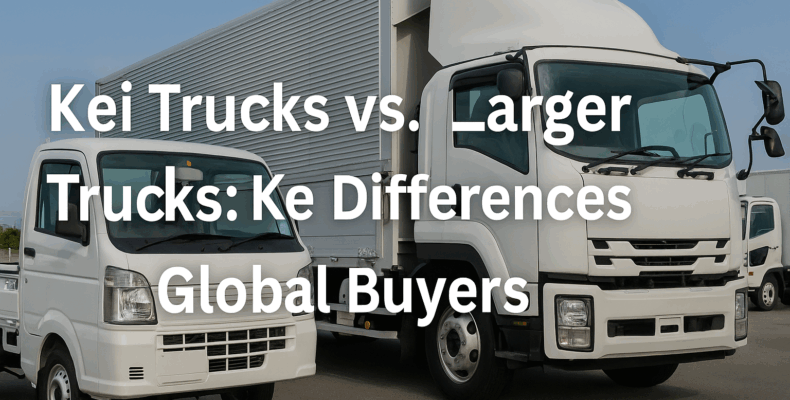When searching for a Japanese used truck, many international buyers face one key question:
Should I choose a kei truck or a full-sized commercial truck?
Although both types serve different purposes, understanding their differences helps you make smarter, more cost-effective choices. So, whether you’re hauling goods in rural Kenya, managing city deliveries in Indonesia, or building a fleet in the Caribbean, this guide will help you select the right truck for your needs.
🚚 What Is a Kei Truck?
A kei truck (or “軽トラック” in Japanese) is a compact, light-duty truck defined by specific size and engine regulations. These trucks are widely used in Japan for agriculture, construction, and short-distance hauling.
Common features:
-
Engine size: Up to 660cc
-
Length: Under 3.4 meters
-
Width: Under 1.48 meters
-
Max load: Around 350–500 kg
-
Popular models: Suzuki Carry, Daihatsu Hijet, Honda Acty
Because of their small size, kei trucks are easy to maneuver, fuel-efficient, and affordable.
🚛 What Is a Larger Japanese Truck?
In contrast, larger Japanese trucks range from 1.5-ton class to heavy-duty vehicles over 10 tons.
Typical characteristics:
-
Engine size: 1.5L to 13L
-
Payload: 1,000 kg and up
-
Cab types: Single, crew, or long
-
Popular models: Isuzu ELF, Hino Dutro, Mitsubishi Fuso Canter
These trucks are built for longer hauls, heavy loads, and industrial-grade tasks.
✅ Side-by-Side Comparison: Kei vs. Larger Trucks
| Feature | Kei Truck | Larger Truck |
|---|---|---|
| Size | Very compact | Full-sized, longer and wider |
| Engine Power | Up to 660cc | 1.5L to 13L |
| Fuel Efficiency | Excellent (15–20 km/L) | Moderate (5–10 km/L) |
| Load Capacity | 350–500 kg | 1–10+ tons |
| Maneuverability | Great in tight spaces | Needs more room |
| Ideal Use | Farms, urban light delivery | Logistics, export, industrial use |
| 4WD Availability | Common | Common, with more torque options |
| Price Range (Used) | Low (USD $1,000–$4,000) | Medium to high (USD $5,000–$20,000+) |
🔍 Which One Is Right for You?
Choose a kei truck if:
-
You’re using it on narrow rural roads or small farms.
-
You prioritize fuel savings and easy parking.
-
You need a simple and affordable vehicle.
Choose a larger truck if:
-
You transport heavy loads or construction materials.
-
You run a logistics business or handle exports.
-
You need a truck for off-road, long-haul, or towing jobs.
🌎 Real-World Applications by Region
-
Africa: Kei trucks are ideal for small farms, but 2-ton trucks like the Isuzu ELF are used for regional cargo.
-
Southeast Asia: In cities like Manila or Jakarta, kei trucks shine in narrow alleys, while full trucks serve highways.
-
Caribbean Islands: Kei trucks suit personal use and gardening; larger trucks handle business logistics.
-
South America: Both types are in demand—kei for light work, larger trucks for cross-country deliveries.
🔧 Don’t Forget Compliance and Parts Availability
Before choosing, check:
-
Import laws in your country (some ban older kei trucks)
-
Parts availability for service and repair
-
Fuel type preference (gasoline vs. diesel)
-
Right-hand drive regulations
👉 Want help from a trusted seller?
Start here:
Top 5 Trusted Japanese Used Truck Exporters for Global Buyers
These companies offer pre-shipping inspections, auction sheets, and support with documents.
✅ Final Thoughts
Whether you choose a kei truck or a larger Japanese truck, both options deliver strong value and long-lasting performance. The best choice depends on how and where you’ll use it. By understanding their differences, you’ll be ready to import with clarity and confidence.
Would you like a 16:9 banner image with the title:
“Kei Trucks vs. Larger Trucks: Which Is Right for You?”
featuring a kei truck beside a mid-size or heavy-duty Japanese truck? Let me know and I can create it for you!
